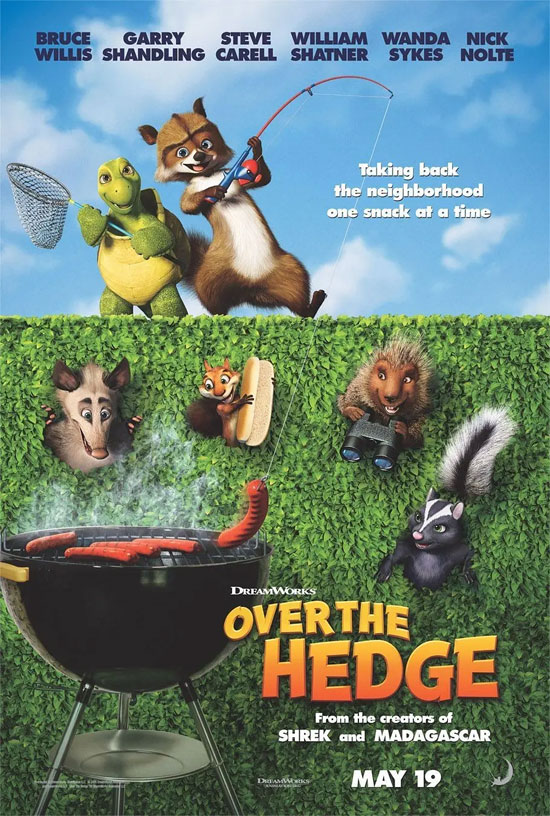Film Name: 篱笆墙外 / Over the Hedge

Watching this DreamWorks animated film from three years ago today, it doesn’t seem particularly high-caliber in terms of either plot or production. Yet I believe “Over the Hedge” possesses a core concept well worth pondering: the hedge. That seemingly endless barrier separating humans from the forest creatures—one that can be leaped over and traversed.
The film’s English title is “Over the Hedge,” and its Chinese translation is also “Over the Hedge.” Yet which side of the hedge truly represents the “outside”? For the animals, the human world lies beyond the hedge. For humans, the forest habitat of the animals lies beyond the hedge. This hedge wall serves as a barrier not only between nature and humanity but also between primitive ignorance and modern civilization. From this perspective, the work indeed portrays the conflict between nature and humanity, as well as the clash between primitive ignorance and modern civilization. Simultaneously, it reveals that humans should protect nature and that even modern civilization should preserve the primitive, simple virtues found in nature.
In fact, “Over the Hedge” could also be translated as “Crossing the Barrier.” Here, the hedge seems to represent not only a physical barrier but also a barrier of the heart—one of deception versus trust, cowardice versus courage, loneliness versus reliance, and indifference versus care. When the protagonist overcomes these barriers of the heart, the story achieves a deeper, symbolic elevation.
The protagonist—a raccoon obsessed with avoiding being eaten by bears, constantly scavenging for food—always carries a human backpack filled with human tools, even golf clubs. Compared to other forest animals, he is essentially a “pseudo-human,” an outsider from beyond the hedge. When other animals awoke from hibernation and gazed at the walls with terror, the raccoon displayed disdain and an air of omniscience. This ambassador of new knowledge and culture even briefly became a hero to the smaller creatures, making their former leader, the green turtle, seem old-fashioned, backward, and overshadowed. Yet this same raccoon, no matter how intimately familiar with the human world—understanding every tool’s purpose, even deciphering the mechanisms of humans’ sophisticated traps—remained fundamentally a raccoon. In other words, relative to humans, it forever occupied the role of an outsider from beyond the fence. Throughout the story, this raccoon first crosses the fence from its natural attributes to its identity attributes—transitioning from nature to humanity. Ultimately, it crosses the fence of the heart, returning from the cold, power-hungry side of humans to the warm, cooperative side of the small animals.
Interestingly, throughout the story, only the small animals repeatedly cross the fence into the human world, stealing food and daily necessities from humans. Yet humans never cross the fence into this preserved primeval forest. When the animals first taste potato chips or witness humans’ fascinating activities, their excitement is palpable. What can they do? Steal it. Cultural permeation is inherently unfair. The advanced side needn’t actively attack; it naturally seeps into the less developed side, unstoppable even by the tallest fences.
That covers the fence metaphor. I’d like to touch on another theme. The most quintessentially American, Hollywood-style sequences in this film are the chase scenes: bears chasing raccoons, dogs chasing small animals, and humans chasing small animals. Each is thrilling and action-packed, elevating the animation to climactic heights. Yet this excitement merely perpetuates the classic action-gimmick formula of American animation—nothing surprising after repeated exposure. While the small animals’ expressions remain vividly animated, they fall far short of the imaginative “transformation” demanded by classic animation.
Furthermore, the story unfolds around a bear’s pursuit, with that same bear ultimately serving as the final boss. This seems to diverge significantly from the intended meaning of the fence. Although the bear does deliver a weighty line in the story—teasing the raccoon that continuing his indifference will lead him to fall as low as the bear—using the bear as the central thread still feels somewhat careless and disconnected from the theme.
Please specify:Anime Phone Cases » Over the Hedge 2006 Animation Film Review: Which side lies beyond the fence?